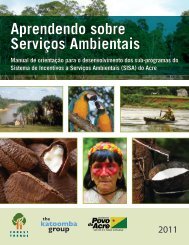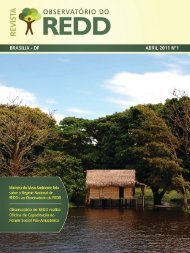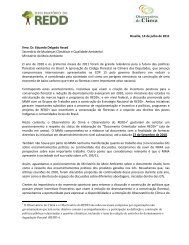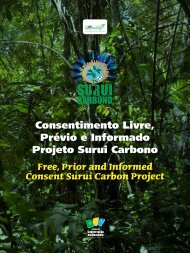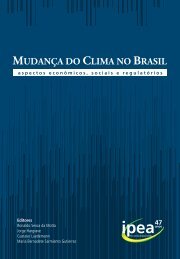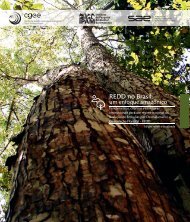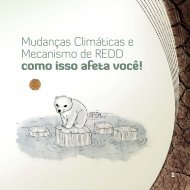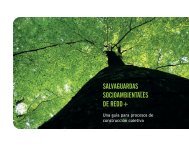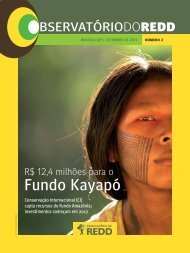Create successful ePaper yourself
Turn your PDF publications into a flip-book with our unique Google optimized e-Paper software.
Dentre as formas de compensação de carbono,as de maior relevância para as terras indígenassão: desmatamento evitado e conservação deestoques de carbono, medido pela Reduçãode Emissões do Desmatamento e DegradaçãoFlorestal (REDD+); e sequestro de carbono,a partir do reflorestamento. Em ambasestratégias, o povo Surui leva vantagem paraobtenção de créditos de carbono. Veja abaixo:Among the forms of carbon compensation, themost relevant for indigenous reserves are: avoidingdeforestation and conservation of carbon stocks,measured through Reduction of Emissions fromDeforestation and Degradation (REDD+); and carbonsequestration through reforestation. Under bothmethodologies, the Surui people have an advantagefor obtaining carbon credits. See below:Redução das Emissõespor Desmatamentoe Degradação (REDD)A<strong>final</strong>, qual o verdadeiro valor das árvores em pé?Responder a essa pergunta é um dos objetivosdesse mecanismo que pretende contribuir paraa redução de emissões do desmatamento edegradação das florestas. Na prática, o REDD+considera a quantidade estimada de carbono,contido na biomassa das florestas, a ser lançadana atmosfera proveniente do desflorestamento, docorte de árvores e dos incêndios florestais.Iniciativas de mitigação das emissões de Gases doEfeito Estufa – GEEs por empresas, instituições ougovernos podem ser feitas por créditos de carbonoflorestais, provenientes de um projeto de REDD+.Este mecanismo de compensação atribui um valoraos créditos de carbono, que valoram a floresta empé e promovem a redução de emissões dos GEEs.Dessa forma, um poluidor pode compensar suasemissões pagando a quem conserva as florestas,retribuindo-o financeiramente.Para garantir a qualidade e contabilidade dosReduction of Emissionsfrom Deforestation and ForestDegradation (REDD+)But what is the real value of keeping the forest alive?Answering this question is one of the objectives ofthis mechanism which seeks to contribute to thereduction of emissions from deforestation andforest degradation. In practice, REDD+ considersthe estimated quantity of carbon contained in thebiomass of the forests, which would be emitted to theatmosphere due to deforestation, the felling of treesand forest fires.Initiatives to mitigate greenhouse gas (GHG) emissionsby businesses, institutions or governments can bedone through forest carbon credits, from REDD+projects. This compensation mechanism gives aneconomic value to the carbon credits, which valuestanding forests and promote the reduction of GHGemissions. In this way, a polluter can compensate fortheir emissions paying those who conserve the forests,rewarding them financially.To guarantee the quality and accounting of carboncredits that will be generated, the project will use



